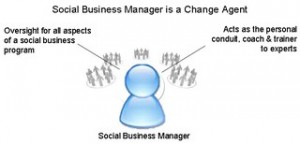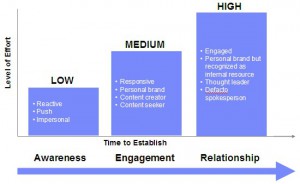An approach to building a training curriculum to improve employee engagement through social media.
Over the course of the last year, I’ve worked with our internal communications & training specialists to lead the develop of an education curriculum to advance employee skills in the area of external social media engagement to benefit our customers and our brand. In this post and several to follow, I’ll share our approach in hopes of helping other brand marketers contemplating building such an education curriculum.
Getting Started
Before you begin creating any materials, it’s important to conduct listening research to understand which venues your customers are most engaged on. Knowing this will help you prioritize the training modules that need to be developed. For example, since IBM’s a large B2B in the tech space, we have specific focus on professional social networks, User Groups, Tech Forums & Communities and Tech related blogs so we’ve prioritized training on these venues. You’ll want to support your employees to advance skills on appropriate venues where your customers & prospects are more likely to connect & develop relationships. Stay away from developing training about the latest tools, there will be several hundred new ones introduced in the next few months and you won’t be able to keep up with them or the enhancements made post release.
Outline clear learning objectives
Once you’ve prioritized the venues important for employees to engage in, you’ll want to map out a curriculum that can accommodate various skill levels from beginner to advanced and begin segmenting the skills each module will deliver. For example:
Blogging 101: The Basics
Learning objectives:
- Identify the basic features of Blogging and its terminology
- Select a hosting platform for your blog
- List techniques to create compelling blog content
- Describe the guidelines and policies for Blogging specific to your brand
Blogging 201: Intermediate – How to Plan, Maintain and Optimize your blog
Learning objectives:
- Identify the need to schedule blogging on your calendar
- Demonstrate how to create compelling content
- List techniques to optimize your blog for search engines to grow your audience
Blogging 301: Advanced – Differentiating and Promoting your Blog
Learning objectives:
- Identify how to differentiate your blog and promote your expertise
- Grow your blog followers and connections
- List tools to help you measure your influence
Training Approach: Show me. Guide me. Let me.
We use a progression of simulations under the framework of Show me. Guide me. Let me. This approach gradually helps learners develop the skills they need to engage in social media on behalf of IBM. More specifically:
1. Show Me (Demonstration): Video simulations demonstrate the steps of procedures to learners, while also showing text that describes the process. Audio is often also provided to explain the steps to learners.
2. Guide Me (Guided Practice): Learners participate in the simulation by clicking the tools they would use in real life, but the tools are simulated. Throughout the simulation, text or audio guides learners through the process within a safe environment where learners can make mistakes without interfering with actual customer information in a live system.
3. Let Me (Assessment): Learners click through a series of steps within lab exercise to achieve desired results, but no guidance is provided during the exercise. Learners rely on their knowledge attained in steps 1 and 2 to complete the simulation. This is the most effective way to know whether learners understand the process.
Training delivery methods
It’s not always feasible to host on-site training. This was the case for us because we’re a global brand, so we use web based collaboration tools like IBM Connections and Smart Cloud to deliver the training. Hosting a series of community based lunch & learns in which the presentation was shared by the trainer during the first 30 minutes and then was opened up for questions and discussion the last 30 minutes. Throughout, participants and moderators are actively using text chat to provide input and ask questions or provide answers. We also recorded each session and made the modules available on our internal intranet portal called the Digital IBMer Hub. Employees to access the modules on demand at a time that is convenient and replay as many times as they like.
Given the quickly evolving nature of social and digital media, you will need the ability to quickly create and distribute training or education to your people—especially as new channels, best practices, or policies emerge or fade. This approach could easily be used to train employees who are active in social media and also to keep them continually equipped with the latest information about your brand.






